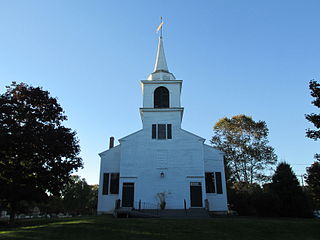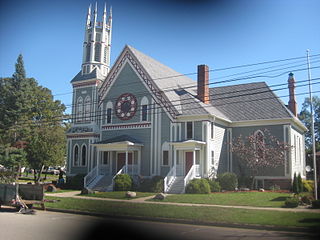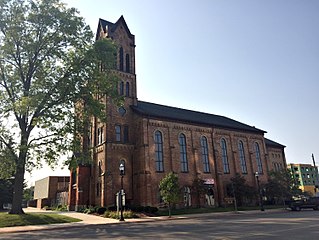
Walnut Hills United Presbyterian Church is a historic church tower in the Walnut Hills neighborhood of Cincinnati, Ohio, United States. The last remnant of a landmark church building, it was designed by a leading Cincinnati architect and built in the 1880s. Although named a historic site a century after its construction, the building was mostly destroyed after extensive neglect caused restoration to become prohibitively expensive.

Allston Congregational Church is a historic Congregational church building at 31-41 Quint Avenue in the Allston neighborhood Boston, Massachusetts. Built in 1890–91 to a design by Allston native Eugene Clark, it is a prominent local example of Richardsonian Romanesque architecture. The property includes a Shingle style parsonage built about the same time. The buildings were listed on the National Register of Historic Places in 1997. The building presently houses a mosque and the Palestinian Cultural Center for Peace.

The Broadway Winter Hill Congregational Church is a historic church building at 404 Broadway in Somerville, Massachusetts. Built in 1890-91 to a design by Hartwell and Richardson for a Congregationalist congregation founded in 1865, it is one of the city's only examples of Shingle style architecture, and one of its finer architect-designed buildings from the 19th century. The building was listed on the National Register of Historic Places in 1989. It is now home to the Vida Real Church.

Rock Hill Presbyterian Church is located at 52644 High Ridge Road in Bellaire, Ohio. The building was placed on the National Register on 2009-02-18.

The South Granville Congregational Church is located on NY 149 in the hamlet of South Granville, in the town of Granville, New York, United States. The current church building is the fourth in the church's history. It is a white frame church built in the 1840s; nearby is a Greek Revival parsonage of similar vintage. The church was extensively renovated and expanded in 1873, giving it more of a Late Gothic Revival appearance.

Acworth Congregational Church is a historic church at the end of the town common in Acworth, New Hampshire. Built in 1821, its exterior is a well-preserved local example of Federal period architecture, with possible attribution to Elias Carter. Its interior now exhibits a Victorian-era design, distinctive because it has survived later alteration. The church was listed on the National Register of Historic Places in 1975. It is now maintained by a local non-profit organization.

The First Congregational Church of Buxton, also known locally as the Tory Hill Meetinghouse, is a historic church on ME 112 in Buxton, Maine. Built in 1822, it is an example of Federal period architecture, having had only modest alterations since its construction.

The Holland Congregational Church is a historic church on Gore Road in Holland, Vermont. Built in 1844, it is a prominent local example of Greek Revival architecture, and is the town's only surviving 19th-century public building. It was built listed on the National Register of Historic Places in 1986.

The Briceville Community Church is a nondenominational church located in Briceville, Tennessee, United States. Built in 1887, the church served as a center of social life and community affairs for the Coal Creek Valley during the valley's coal mining boom period in the late-19th and early-20th centuries. In 2003, the church was added to the National Register of Historic Places for its historical role and as an example of rural Gothic Revival architecture.

Pilgrim Congregational Church is a historic congregation of the United Church of Christ in Cleveland, Ohio, United States. Constructed in the 1890s for a congregation founded in the 1850s, it was named a historic site in the 1970s.

Independence Presbyterian Church is a historic church in the city of Independence, Ohio, United States. Constructed in the 1850s, the stone church building was originally home to a congregation heavily dependent on the local mining economy, but since the 1920s it has again been associated with an active congregation. It was named a historic site in the 1970s.

The Auburn Free Will Baptist Church is a historic former Baptist church building in Auburn Township, Geauga County, Ohio, United States. Constructed in the second quarter of the nineteenth century, it is no longer home to the congregation that built it, but it remains a significant component of the area's built environment, and it has been named a historic site.

The Macedonia Baptist Church is a historic former Baptist church building near the community of Burlington at the southern point of the U.S. state of Ohio. Constructed in the middle of the nineteenth century, it held a significant place in the culture of the local black population, and it has been named a historic site.

The Welsh Congregational Church is a historic church in Youngstown, Ohio, United States. Formed by some of Youngstown's large Welsh American community, it was once the center of Welsh life in Youngstown, and it has been designated a historic site.

Trinity Lutheran Church is a historic former Lutheran church in downtown Canton, Ohio, United States. Built in the 1880s for a flourishing congregation, it closed in the early 2010s, leaving behind a church building that has been named a historic site.

The Octagon, Christchurch, the former Trinity Church or Trinity Congregational Church designed by Benjamin Mountfort, later called the State Trinity Centre, is a Category I heritage building listed with Heritage New Zealand. Damaged in the 2010 Canterbury earthquake and red-stickered after the February 2011 Christchurch earthquake, the building was threatened with demolition like most other central city heritage buildings. In June 2012, it was announced that the building will be saved, repaired and earthquake strengthened.

First Congregational Church, also known as Garnavillo Historical Museum, was a church whose historic building is located on Washington Street in Garnavillo, Iowa, United States. It was built in 1866 and was added to the National Register of Historic Places in 1977.

First Church Congregational is a historic church at Pleasant and Stevens Streets in Methuen, Massachusetts. The stone Gothic Revival structure was built in 1855 for Methuen's first congregation, established in 1729. Its first meeting house was on Daddy Frye's Hill, but moved to the present location in 1832. The present building features granite walls, a slate roof, and a tower with crenellated top and typical Gothic lancet windows. In 1895 the church installed a stained glass representation of Christ's Resurrection designed by John LaFarge.

The First Congregational Church of Ovid is a religious building in Ovid, Michigan. It was designated a Michigan State Historic Site in 1971 and listed on the National Register of Historic Places in 1972. Registered Site #: Local Site #0114

The First Congregational Church is a historic church in downtown Jackson, Michigan, adjacent to the original city square. It was listed as a Michigan State Historic Site in 1987 and added to the National Register of Historic Places in July 2017. The church is currently home to the First Congregational Church, United Church of Christ of Jackson.






















